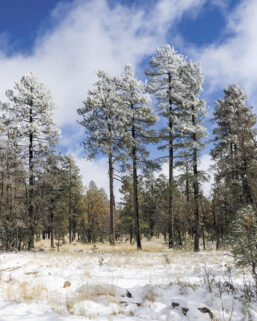Gerry Tietje
The Mogollon Rim is one of the most striking geological features in Arizona. This massive break in the earth’s topography stretches more than 200 miles across central Arizona into New Mexico. The escarpment, which features towering Kaibab limestone and sandstone cliffs and sheer drop-offs of 1,000 feet or more, is often called the “backbone of Arizona.” The Mogollon Rim forms the southern border of the Colorado Plateau, an area that boasts the largest stand of ponderosa pine trees in the world! South of the Rim, the ponderosa pines abruptly transition to juniper and pinyon pine forests, and further south, to the environment most people think of as Arizona, namely the Sonoran Desert with its giant Saguaros.
Most historians and geographers believe the Mogollon Rim was named after Juan Ignacio Flores Mogollon, a Spanish military officer who became governor of what is now New Mexico from 1712 to 1715. Others believe it was named after the Spanish word for mistletoe, an invasive plant that is known to harm ponderosa pines. Regardless, the unusual name is frequently mispronounced, the correct pronunciation being moh-guh-yohn.
The Mogollon Rim attracts visitors throughout the year. Cities and towns located near the Rim include Strawberry, Pine, Payson, Show Low, Alpine, and Pinetop-Lakeside. They are crowded in summer when people want to escape the oppressive heat in other parts of the state. At other times of the year, the Mogollon Rim is less crowded and features explosions of wildflowers in spring, pockets of colorful maples and small aspen groves in fall, and snow and cold weather in winter.
Forest roads are probably the best way to experience the Rim area. Most are well-maintained, but it’s best to have a high-clearance vehicle to safely navigate them. A drive along Forest Road 300 between Highways 87 and 260 offers stupendous views of the Rim topography; numerous hiking trails; lake access for boating and fishing; many camping sites; and chances to see birds and animals not seen in other parts of Arizona, including pygmy nuthatches, elk, and Abert’s squirrels.
One of my favorite times to visit the Mogollon Rim is in November before heavy snows have fallen and the forest roads are closed for the winter. Early last November my wife and I drove to Payson to visit the Rim. A light snow had fallen the night before, but the forest roads were still open. As we drove our Subaru along Forest Road 300, we were treated to glistening snow and ice-covered ponderosa pines, their scintillating boughs piercing a deep blue sky. Mesmerized, we pulled off the road and walked along a path beside the Rim, enjoying a fantasyland of foggy views across the abyss, ice crystals hanging from bronzed oak leaves, and Steller’s Jays chattering in the branches of a dead tree that had grown out of a rocky crag. The Mogollon Rim is an awesome place, and I hope this article will encourage you to visit or revisit the backbone of Arizona.


